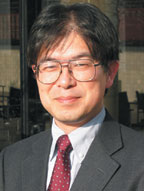
 |

|
HIRAHARA Tatsuya Human Information Science Laboratories |
|
Recently, everything from personal computers and car navigation systems to mobile phones and various household electrical equipment has begun recognizing our voices and speaking to us. The media often reports on the development of a smart vision system that can discern individual's faces and facial expressions as humans. Furthermore, various kinds of software packages for studying foreign languages that use such information and communications technology (ICT) are on the market. It is therefore no wonder that people are under the impression that recent ICTs are really marvelous. They might even ask if there is anything left to research. Reality, however, is not that simple. We are often disappointed with the poor performance of this kind of equipment and software after we actually use them. This is likely because current technologies that mimic human functions as seeing, hearing and speaking are based on a statistical pattern recognition/synthesis method. It aims to classify/generate patterns (speech, face, whatever) based on statistical information extracted from a large number of patterns, assuming that the patterns are generated by a probabilistic system. Key formulae used in the technologies can be found in the financial engineering field, which became infamous in the derivative-driven hedge fund collapse. If input patterns are included in the pre-collected data that is used to extract statistical information for a system, the system works reasonably well. If not, however, the system betrays itself. Since the real world is so diverse, the patterns we generate are also diverse. It is, thus, impossible to collect all data in advance. Expecting computers based on such technologies to see, hear or speak just as humans do may be extravagant expectations. Over the eons, the brain has been refining its information processing strategies and mechanisms to survive in the real world. To grasp what is going on in the real world, the brain generates appropriate internal information quickly using fragments of information received from the five senses, which usually actively get real world information. But how does it work? We have learned surprisingly little. If we liken the status of brain science to physics, we might be in a pre-Newton or pre-Galileo era, with no Principia, let alone quantum mechanics. Accordingly, we have to tackle many critical issues to clarify how the human brain processes information. Even though ICTs are advancing rapidly, the principles underlying human communication remain obscure. As technologies advanced, the capacity to accumulate, process and transmit information has increased dramatically in the late 20th century. This has enabled us to easily access and send various kinds of information through the Internet. Searching information, network shopping and exchanging e-mail messages with photos and video clips through networks have become more and more convenient, accessible and usable. At the same time, the risk of encountering unexpected information has also increased. Insidious computer viruses are an example. Information can be hazardous, as we realized after the Pokemon incident. On December 16, 1997, over 600 people across Japan, mostly children, suffered convulsive seizures and other symptoms while watching the animated TV program “Pocket Monsters.” A number of people were hospitalized. The cause is believed to be photosensitivity to the strong flashing lights used for the video effects in the animation. Information technologies and information itself that is incompatible with human information processing mechanisms are not only useless but potentially harmful. We can continue to be ignorant of the human information processing mechanisms, but the price will eventually be paid by current or future generations. ATR Human Information Science Laboratories are conducting transdisciplinary scientific research aimed at clarifying the human information processing mechanisms related to how humans see, hear and speak. Our mission is to gain a more comprehensive understanding of the mechanisms underlying human communication. We aim not only to enhance the basic capabilities of humans and computers, but to foster technological development for more natural and enriched communication among people as well as among people and computers. In the 20th century, the technical specifications for telephones and television systems were defined based on the basic characteristics of human ears and eyes. Further advances in ICT should bring us a new crop of communication equipment and content. Even so, they cannot be unrelated to human information processing mechanisms. It is thus becoming more and more important to deepen our understanding of how we generate and perceive information. Science is the free and open pursuit of nature. As such opportunities are provided, we will continue to pursue scientific research that excites ourselves and people supporting us. We will also promote research on ICT that enriches the global environment and the lives of people on this planet. In this final frontier, we have a chance to become the next Newton, Einstein, Alexander Graham Bell or even the future Zefram Cochrane. |
||
|
|